Philip Freeman, teacher at Richmond Secondary School (Richmond BC), Executive member BCAPT
freeman@sphericalcows.net
Black holes are big news these days. Unfortunately a significant number of statements in the press are not only mistaken but wrong in ways that obscure the truly interesting and important things we know about black holes. This article hopes to clarify a number of points about what black holes are and are not.
A Brief Word about General Relativity
Describing black holes requires that we look at General Relativity (GR), our best theory of gravity and one of the most successful theories in all of physics. Physicists who study GR consider the theory extremely elegant and beautiful. Starting with a few very basic and logical assumptions (such as the idea that everyone should have the same laws of physics) the theory unfolds naturally and inevitably. Mind you, the math does get tricky and this is in part because the curvature of spacetime (aka the gravitational field) depends on the energy/stress/momentum present there. It also includes the energy of curved spacetime, so gravitational fields have a ‘feed-back’ aspect that makes the math rather involved. (Einstein had to get help to learn the advanced math he needed for the theory!) To this day it is rare for people to find ‘exact solutions’ of these equations and for anything complex, we need to use computers and numerical methods. Black holes are a solution to the equations of GR; in particular they are a
vacuum solution. This means that the equations that describe a black hole do not require any matter at all!
But if a black hole isn’t made of matter then what creates the gravitational field of a black hole? The answer is that the gravitational field of the black hole is created by the gravitational field of the black hole! Remember that feedback we mentioned last paragraph? Yeah, positive feedback can ‘run away’ with itself, like the feedback with a speaker and microphone. A black hole is what happens when this occurs to spacetime curvature.
But what about collapsing stars? What about all the stuff that falls into a black hole? How can I say black holes have no matter when obviously they do? A black hole can start out with mass but it needn’t stay that way. To form the black hole we need a lot of mass-energy in one place, in whatever form that energy takes; matter, light or gravitation itself. However, once it forms, all traces of what started that weird feed-back loop are lost. The black hole is exactly the same whether it is made from a collapsing star or a cloud of dark matter, or an exceedingly large number of turnips.
The fact that a black hole is made of its own gravity will be important later, so keep that idea in mind!
Light Cones and Spacetime Diagrams: A Quick Introduction
In both Special Relativity and GR we are looking at time and space as a single thing - spacetime. That makes three dimensions of space and one of time, so four dimensions together. That’s hard to keep track of, so we use a simplified picture with just one dimension of space and one of time. Traditionally we put time going upwards and space going right/left. Moving objects trace out lines on this picture:

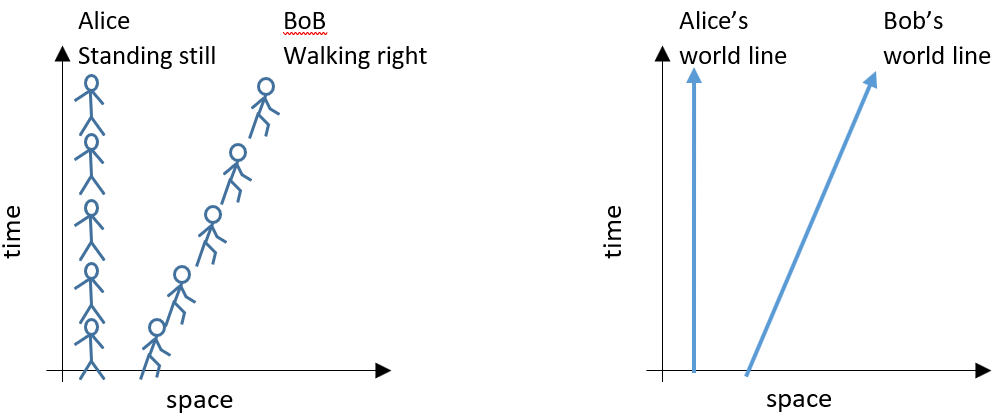 Figure 1: World lines
Figure 1: World lines
Light, you will recall, always travels at the same speed (locally) so a useful way to see causal structure is to add ‘light cones’ showing the paths of light. These form the limits on how something can move and what it can affect. Things inside the light cone are in the future/past, things outside of it are places you can’t affect.

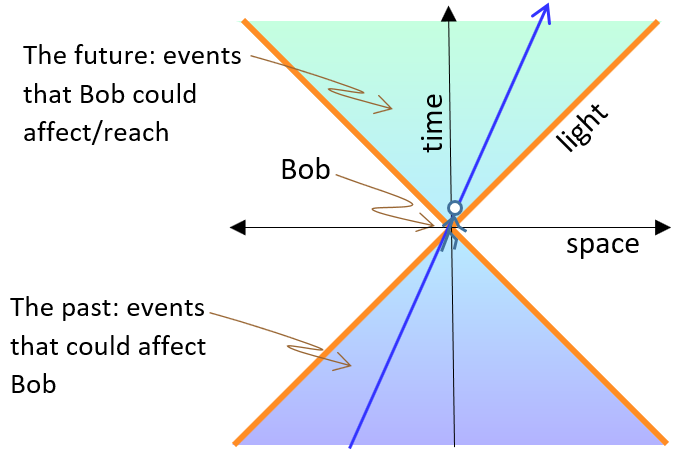 Figure 2: Light cones
Figure 2: Light cones
We commonly use different units for space and time. This is just a quaint convention we are used to, similar to how my local grocer still sells produce by the ‘pound’ but candy ‘per 100g’. In relativity it is handy to use the same units for both, so light speed is just 1 metre per metre. This means that a light cone makes an angle of 45°. (This will not be true when spacetime gets distorted relative to the diagram’s coordinates, as we will see later.)
Basic anatomy of a black hole
Let’s start with one of the first solutions to the GR equations, which describes spherical masses that aren’t charged or rotating. An exact solution in this case was discovered by Karl Schwarzschild (who was dying on the Russian front of WWI as he worked on it!) If the mass gets too concentrated the field becomes intense enough to trigger that run-away gravity we mentioned and the equations describe the resulting black hole.
This black hole depends only on the amount of mass/energy present, and is very simple. If we add charge and spin things get a little more complex, but only a little. Black holes quickly radiate away any initial detail and become totally described by just those three things. (This is known in physics as “Black holes have no hair”). Once you know the mass of a Schwarzschild black hole, you know everything about it.
The effect of that run-away gravity is to create a region that is completely cut-off from the rest of the universe. The edge of that region is called the ‘event horizon’ because everything past it has vanished like something going over a horizon. It can neither escape nor affect anything in our region of space and time. We call this cut-off region the “inside” of a black hole, but you need to remember that this region isn’t part of the universe anymore. It isn’t a place that is separated from us by a barrier. It is gone completely and it isn’t meaningful to ask what is inside the black hole ‘right now’ because our time here is unconnected to the time “inside”. This can be hard to grasp. It is hard to shake the belief that time is time and the same for everyone but we have to give up that idea even in special relativity.
The event horizon is spherical for a Schwarzschild black hole, and the radius of that sphere is often called the ‘radius of the black hole’ or sometimes ‘the Schwarzschild radius’ (rS). This radius isn’t describing the distance from the event horizon to the ‘centre’ of the black hole, it’s just describing what the black hole looks like on the ‘outside’:

 Equation 1: Schwarzschild radius
Equation 1: Schwarzschild radius
 Figure 3: Anatomy of a black hole
Figure 3: Anatomy of a black hole
OK, so what is it that we need to understand (or unlearn) about black holes?
So, about that radius…
Let’s start with the Schwarzschild radius itself, which I often see calculated from Newtonian gravity as “where the escape velocity becomes greater than light speed”. It is true that if you take a mass and calculate the radius of an object with that mass having an escape velocity is equal to that of light you get the size of the Schwarzschild radius of a black hole. You get the right answer, but for the wrong reasons; gravity isn’t Newtonian and light isn’t losing kinetic energy based on ½ mv2. In fact getting the right result here is more coincidence than helpful. But it’s so tempting to give the students a mathematical method that gives the right answer that we ignore the fact that the method is nonsense. I confess I have done this myself, so no blame here. But I don’t anymore… I believe we can and should do better. More on this later!
Misconception: Black holes suck!
Despite their portrayal as cosmic vacuum cleaners, black holes are actually no more forceful than any other gravitational source. A black hole with a mass equal to our sun would pull on the things around it with a gravitational force exactly the same as that of the Sun at the same distance. Gravity is gravity is gravity no matter where it is coming from.
Black holes are not more powerful than any other gravitational source. They just get much more intense. The gravitational field or spacetime curvature becomes more and more extreme the closer you get to the source. All round objects – stars, planets and black holes – act like point sources. But for most objects you can only get so close before you actually hit the object. If you get closer, by going inside the object, some of the force cancels and the gravitational field falls off. But smaller and denser objects like black holes or neutron stars allow one to get closer before that happens, resulting in more intense gravitational effects. Black holes are the smallest and most tightly packed objects possible. (Our best models say they are mathematical points, but everyone expects that will turn out to be not quite true!)
In the picture below I am using shades of grey to show the intensity of gravity:

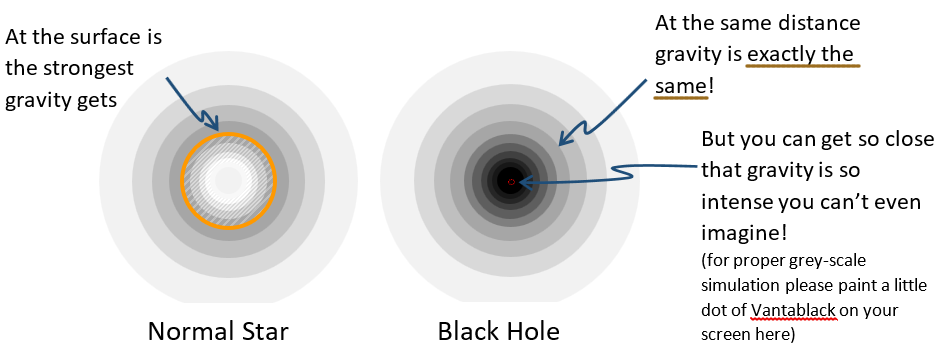 Figure 4: Intensity of gravity
Figure 4: Intensity of gravity
Remember all the fuss that the Large Hadron Collider might create a black hole? Such a black hole, if it could have been created, would have had a mass of about 0.00000000000000000002 g, and a gravitational pull to match. Its Schwarzschild radius would be 3×10
-50 m! This is not going to gobble up the Earth anytime soon!
Some black holes have masses very much greater than the Sun, including the two that were photographed by the Event Horizon telescope. The one at the centre of our galaxy, Sagittarius A* has a mass equal to more than 4 million Suns and the one at the centre of M87 has a mass of 6.5 billion Suns. But even so, all of the intensity is in close to the black hole and not reaching out to grab things far away.
Black holes don’t suck in another way. Black holes are very messy eaters (I always think of Sesame Street’s Cookie Monster)! It is actually quite hard for a single object to fall into a black hole. It can fall towards it and as it falls it goes faster and faster. Unless it is aimed more-or-less exactly at the black hole it will simply whip around the black hole without getting very close to the event horizon and escape with the same speed it came in at. This is true of any gravitational object, but because black holes are so compact it is that much harder to actually hit one!
If a bunch of mass is falling toward a black hole, the different parts can collide with each other, turning some of that kinetic energy they gained into thermal energy. In this case the matter will form a very hot and rapidly spinning disk around the black hole called an accretion disk. With continued interaction and energy lost to heat, some of the mass will fall into the black hole. Some will be thrown outwards. This is especially true if the black hole has charge and spin, producing a magnetic field. This field can become very intense and twisted and can propel the material outwards in high velocity ‘jets’:
 Figure 5: An artist’s conception of the accretion disk and jet around M87
Figure 5: An artist’s conception of the accretion disk and jet around M87
Image ESO/M. Kornmesser (https://cdn.eso.org/images/large/eso1907c.jpg)
All this action means that a lot of the material that falls toward the black hole doesn’t fall in, but is scattered outward as matter, light, and other forms of radiation.
Misconception: Black holes will eventually swallow everything in the universe
Now that we know that black holes are messy and not very good at absorbing matter it should be no surprise that there aren’t a lot of scenarios where most of the mass of the universe ends up inside black holes. In fact most of the mass in the universe is especially hard for black holes to capture, because it is in the form of dark matter. It won’t form an accretion disk since it doesn’t interact with itself.
Even regular matter is most likely to stay in the form of interstellar dust and gas. There just isn’t enough gravity to bring it together to form stars or find its way to a black hole, even if the universe were static, much less in the endlessly expanding universe we seem to inhabit.
Misconception: Black holes are where “the escape velocity is greater than that of light”
This is the number one popular description of black holes, sometimes rephrased as “A black hole is an object whose gravity is so intense that nothing, not even light, can escape”. A correct description is “Nothing can emerge from the event horizon of a black hole.” Another one that is iffy but sort of true, is “Nothing can escape from inside a black hole.” However, the statement that “Nothing inside a black hole can travel fast enough to escape.” is false. So what’s the difference?
What happens if we aim a light upwards in a black hole? As an undergraduate I asked this question of one of my professors, who passed me along to talk to one of the leading theorists on black holes, the brilliant and unfailingly kind Werner Israel (He’s one of my heroes). He patiently listened to my explanation, and then explained that inside a black hole there was no such direction as ‘up’! It was a revelation to me that made so many other things click into place. How can there not be such a direction? There is surely a down isn’t there?
Consider what happens to an object that is falling into a black hole. We need to consider the light cones, which show the ‘causal structure’ at a given place in spacetime. The effect of the gravitation of the black hole is to tip the light cones. Just how to show this requires making some choices, because (unsurprisingly perhaps) in these extreme circumstances there isn’t a unique way to draw our coordinates. Here is one perspective, focusing on orientation… but any picture will only capture an aspect of the full truth!
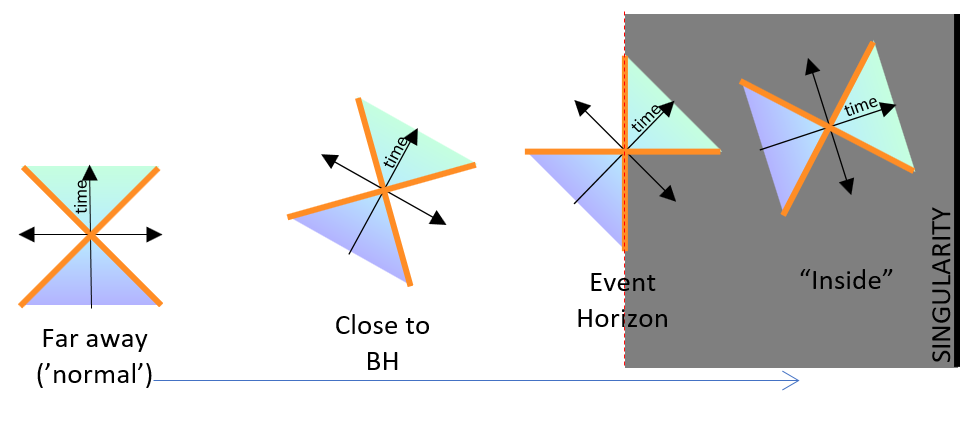 Figure 6: Tipping light cones
Figure 6: Tipping light cones
Notice that at the event horizon the light cones tip over. The light cones are pointed towards the singularity. What this means is that the singularity at the centre of the black hole is not in the downward direction of space — it is in the forward direction of time! And ‘outwards’ is backwards in time.
Now we can see what it means to say that up is not an available direction. Up is the direction of the past. If one were ‘inside’ a black hole then one could no more aim ones flashlight ‘upwards’ than one could aim it at last Tuesday. Similarly for a spaceship or anything else — there is no direction to point your ship that is ‘away’. There is no ‘escape velocity’ for something inside a black hole not because it is ‘greater than the speed of light’ but because there is no direction to go! Escaping from a black hole doesn’t require faster than light travel, it requires time travel.
Misconception: Something fell into the black hole, so now it’s inside the black hole
That’s obvious, right? Yet there are a couple of problems with this description, the biggest one being the word “now”. Remember that the event horizon is the boundary that separates the cut-off part of the universe (the black hole) from everything else. That’s not separated like a wall; that’s separated in a far more profound way. This is because time near a black hole behaves differently than time far away from it.
Anyone who has seen the movie Interstellar will be familiar with the fact that the astronauts who visited planets close to the black hole passed through years of Earth time while only hours passed for them. The closer one gets to the event horizon of a black hole, the slower time passes relative to an observer far from the event horizon. The closer you get to the horizon the more extreme the slow-down is:
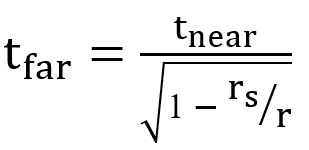 Equation 2: Gravitational time dilation
Equation 2: Gravitational time dilation
The closer a clock is to the event horizon the slower it will tick compared to a clock far from the black hole. (It isn’t just that the clocks are different; time itself is passing differently.) Suppose you had a magical transporter and you could lock onto an astronaut who was falling toward a black hole. You would always be able to ‘beam them out’. This is because you would never see them crossing the horizon (if the horizon stayed static). The event horizon is infinitely far in the future relative to an outside observer.
In other words, perhaps unsurprisingly by now, the event horizon isn’t so much a boundary in space; it is a boundary in time!
Here is a sketch of the world-line of something falling into a black hole, this time trying to keep things in the coordinates of an outside observer, which causes the coordinates of the falling observer to shift in interesting ways:
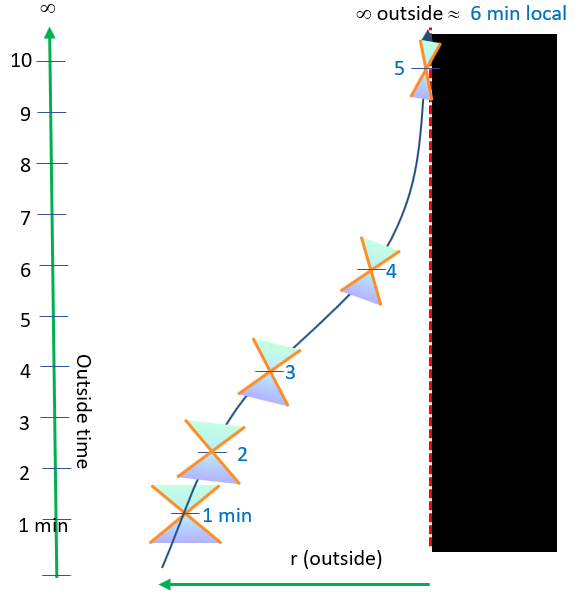 Figure 7: Falling in(ward)
Figure 7: Falling in(ward)
If it takes infinite outside time to reach the event horizon, then how does anything ever fall in and how does a black hole get bigger?
First, from the point of view of the in-falling astronaut there is still a finite amount of time passing — about 6 minutes in our picture. This time is decoupled from ours, which is what a black hole event horizon is all about. Remember that the astronaut is entering the separate space and time of the black hole’s “interior” so our outside time doesn’t apply to them. This is why it is wrong to say that the object that falls into the black hole is inside now. ‘Now’ is an outside-the-black-hole time and not connected to ‘inside the black hole’. You can’t talk about objects in our part of the universe and objects in the black hole part of the universe at the same time, there isn’t a ‘same time’!
Second, the event horizon isn’t static! In a real sense the object does eventually become part of the black hole, though not at the time you think it fell in. As objects fall into the black hole, the black hole gains mass-energy and the horizon grows! Indeed, it grows to meet the object falling in. So you could say that objects falling in don’t really cross the event horizon, the event horizon crosses them!
Misconception: The gravity of a black hole comes from the mass inside it.
If nothing can escape from a black hole and if the ‘inside’ isn’t relevant to the ‘outside’, then how does gravity ‘get out’?
Recall that in our brief discussion of general relativity earlier we mentioned that the black hole is a vacuum solution of the GR equations — that means it doesn’t require that there be anything inside. As we suggested there, a black hole is really made of its own gravity! The mass of the black hole is contained in the gravitational field (spacetime curvature) of the black hole. From the outside, all the gravity comes from the gravitational field itself.
The properties of a black hole — its mass, charge, and spin — when viewed from any point outside the event horizon appear to be either on the surface of the event horizon itself or in the curved spacetime that surrounds the horizon. Consider what happens when two black holes collide. In the first direct gravitational wave observation by LIGO, a ~30 solar mass black hole merged with a ~35 solar mass black hole, resulting in a ~62 solar mass black hole and released ~3 solar masses worth of energy.
That energy came from the gravitational fields of the black holes, not out of the “insides”.

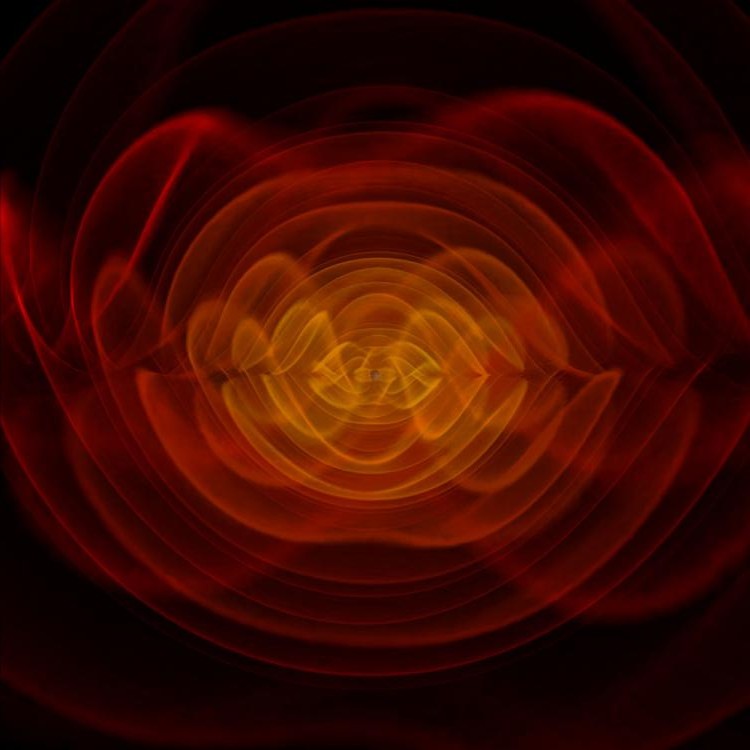 Figure 8: Gravitational waves emitted from merging black holes
Figure 8: Gravitational waves emitted from merging black holes
Image source: NASA/C. Henze (https://www.esa.int/spaceinimages/Images/2015/09/If_our_eyes_could_see_gravitational_waves)
Misconception: Hawking radiation comes from virtual antiparticles falling into the black hole.
There are two different misconceptions here.
First, all energy added to a black whole increases the mass and the Schwarzschild radius of the black hole. Matter, antimatter, light, or anything else that carries energy — it is all the same.
The term virtual, as in virtual images in optics or virtual reality, I usually explain as meaning “real, but not really real!” I often encounter people who want to know “are virtual particles real?” By this I think they mean are they actually there or are they fictional ‘calculation tools’ like the imaginary reflected charge we use to find the electric field near a conductor? The thing is that when it comes to virtual particles there is no difference between these two options! There is no way to distinguish between these two possibilities and so in the strange logic of quantum mechanics they are both equally true. Virtual particles arise from one way of looking at the fields that quantum field theories describe and so do the real particles that we are familiar with! Under the right circumstances you will see the fields as a particle and under others you will find that a field-wave description is more helpful. Both are true, but incompatible descriptions. Welcome to the wonderful world of the quantum! The existence of virtual particles is a matter of point of view… sometimes literally! Under certain circumstances it is possible for me to see real particles, but you would describe them as virtual.
So let’s go with the existence of virtual particles as being a useful construct for now. We can imagine space as full of virtual particle pairs, ‘existing’ (or perhaps better describe as ‘manifesting’) for very brief periods. The near universal picture of this uses particles like electrons or protons:
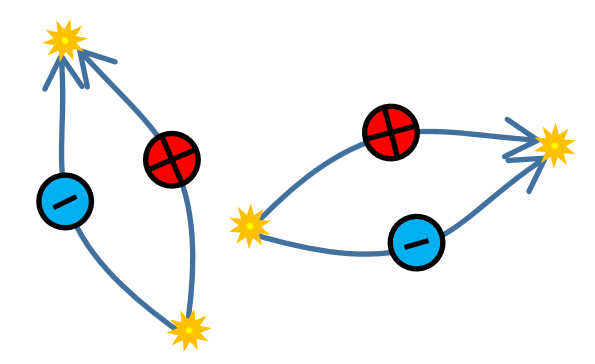 Figure 9: Virtual particle pairs as commonly drawn
Figure 9: Virtual particle pairs as commonly drawn
These pictures show matter and antiparticle pairs coming into ‘existence’ for a little while then mutually annihilating into nothing again. It is a very pretty and easily understood picture. It is also (surprise!) almost entirely wrong.
These pictures are based on a clever mathematical tool developed by Richard Feynman, called Feynman diagrams. They allow physicists to keep track of the complex calculations they need to do in Quantum Field Theory by tracking all the virtual particles that would describe an interaction and then computing the overall field effect using that model.
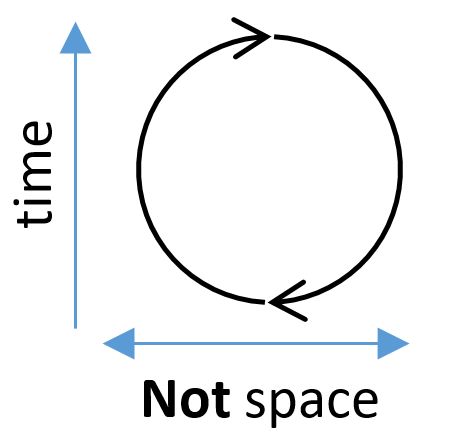 Figure 10: A Feynman diagram of a virtual particle pair
Figure 10: A Feynman diagram of a virtual particle pair
The problem is that these diagrams are not intended as pictures, or even spacetime diagrams. They are more abstract than that. The whole message of the Feynman diagram above is that a particle and antiparticle appear (from nowhere) and then disappear again. If we understand the diagram in this abstract way it’s fine (though doesn’t tell us much, it is really a step toward setting up equations and not stand-alone). But using these diagrams as pictures tells a different story. It says “a particle and antiparticle appear from nowhere. They move apart then are drawn back together and stop existing.”
But what force ‘draws them back together’? These paths appear to be the paths of particles (rather more explicitly in the first diagram of such ‘pairs’, where the picture looks like a deliberate attempt to show just such a motion). But particles that separate and recombine must be experiencing a force of attraction. What force could this be?
Perhaps they are drawn back to their lost partner, longing for the sweet embrace of oblivion? That doesn’t seem like physics, and it certainly implies some strange new properties for particles to have. Or (as I commonly see people assume) perhaps they are drawn back together because one is positive and one is negative — so they attract! But if that were so then only charged particles could form virtual pairs like this, and that is not true. Further if this was a force, of the sort we know, bringing the particles back together, then higher energy particles, with higher kinetic energies, would take longer to be pulled back together and would remain manifest for longer times — the exact opposite of what really happens.
Here is a version of a very common image that will turn up in any image search for “Hawking Radiation”
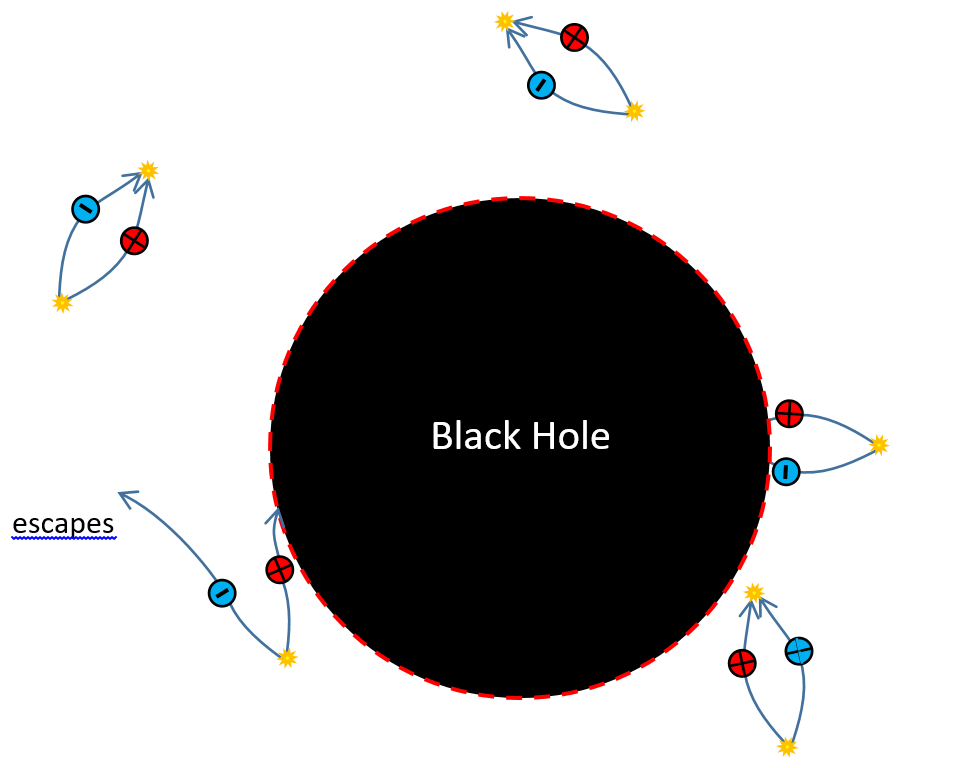 Figure 11: A very common ‘picture’ of Hawking Radiation
Figure 11: A very common ‘picture’ of Hawking Radiation
You can see how all these issues with this model of virtual particles are front and centre.
Virtual particles, however, are not classical particles. They do not have trajectories, just as electrons do not have trajectories around atoms. Showing them as a little ball following a path gives the wrong impression and leads people to think of them in unhelpful ways. Because I see exactly these misconceptions often in my students (and elsewhere), I prefer a different ‘picture’ for virtual particles. I also think it is more helpful for understanding Hawking radiation.
Let’s start with the fact that during almost the entire lifetime of a black hole any evaporation is in the form of photons, like any other black body. This doesn’t have the ‘nice’ annihilation picture, but it can be shown rather nicely if we think, not of particles, but of the wave aspect of light (or anything else thanks to wave particle duality).
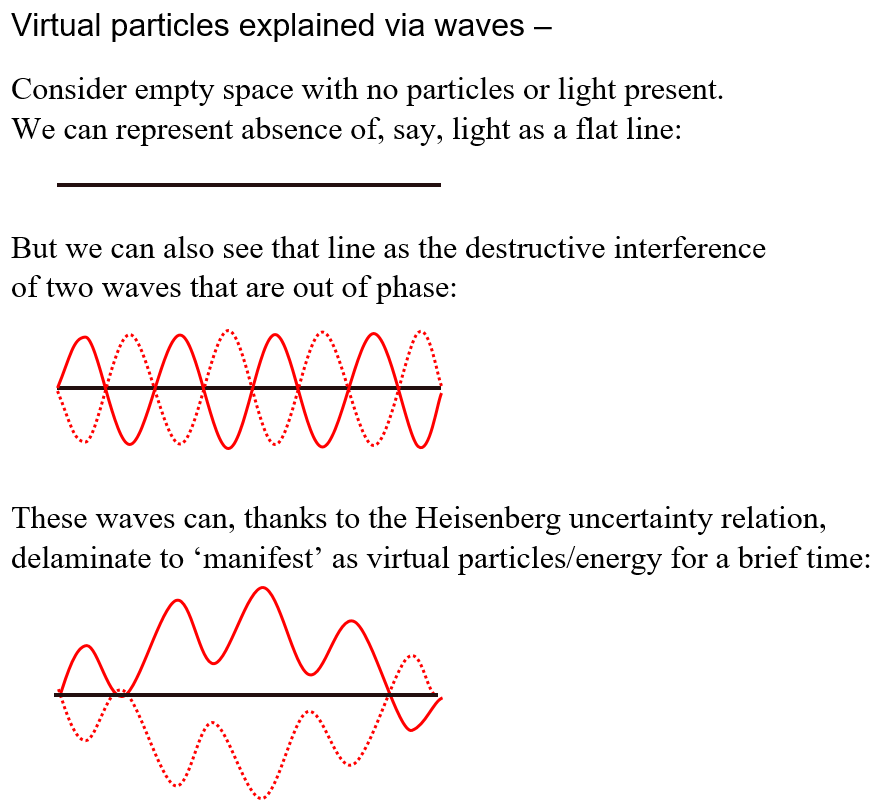 Figure 12: Virtual particles can be understood using wave-particle duality
Figure 12: Virtual particles can be understood using wave-particle duality
Notice that each part of the wave has energy while it is separate, even though in some sense there is still ‘nothing’ there! This is the nature of virtual particles. We have manifested virtual photons.
But suppose something happened to one part of that set of waves (one of the virtual photons)? Suppose it got too close to a black hole, for example? Then that part is red-shifted into oblivion. It is smeared out across time. Meanwhile, the other part of the wave is no longer ‘cancelled out’ and will escape.
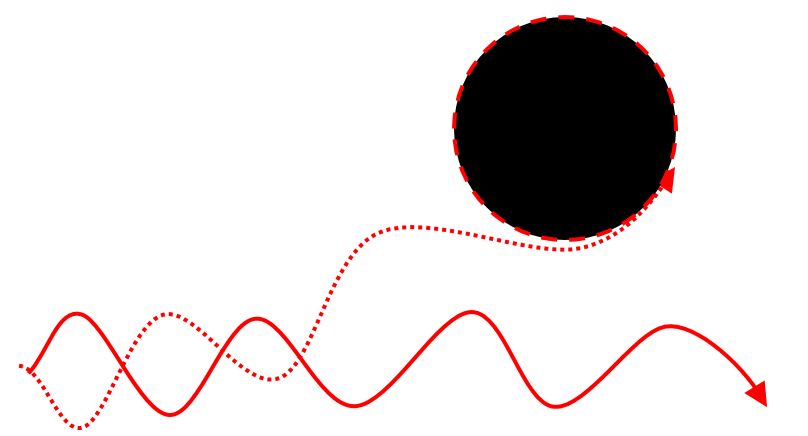 Figure 13: Hawking Radiation
Figure 13: Hawking Radiation
This is what can happen near a black hole and why black holes give off light, despite the ‘nothing escapes’. The energy of this light comes from the gravitational field of the black hole, so the energy content of that field (which is the mass of the black hole, remember!) goes down. The black hole has emitted energy but nothing has ‘escaped’. The process has nothing to do with the “inside” of the black hole!
It is worth noting here that the peak wavelength of emitted radiation is about 16 times the radius of the event horizon, meaning that for all but the very smallest black holes the radiation corresponds to a very low temperature and certainly does not consist of electrons or other massive particles! We can calculate that to get “hot enough” to give off electrons the mass of the black hole would have to be below about 2.1×10
13 kg, or about 10
-17 solar masses with an event horizon about 3×10
-13 m, a thousand times smaller than an atom.
Misconception: Hawking radiation means all black holes are evaporating
Eventually this will be true, but at present it is likely that any black holes that exist are increasing in size, not decreasing.
This is simply because the effective temperature of black holes is very very very very low. The peak wavelength of the thermal radiation from a black hole is much larger than the size of the event horizon. This wavelength corresponds to a temperature that is far lower than the background temperature of the cosmic microwave background, never mind any infalling matter or other radiation.
The temperature of a black hole of mass M is
 Equation 3: Temperature of a black hole
Equation 3: Temperature of a black hole
so a black hole will be unable to evaporate in the current age of the world if its mass is greater than
 Equation 4: Maximum mass to evaporate
Equation 4: Maximum mass to evaporate
(It would actually have to be less than this, since this leaves out any other matter or radiations that could be absorbed).
A black hole can form from a collapsing star with a mass greater than several solar masses. A solar mass is about 1.5×10
30 kg, so stellar black holes won’t evaporate. It is possible that in the very early universe smaller black holes could have been created by fluctuations in density when everything was packed way closer together but they’d also tend to grow rather than evaporate. A careful calculation over the history of the universe (J. Rice and B. Zhang, “Cosmological evolution of primordial black holes”,
Journal of High Energy Astrophysics, V:13-14 p.22-31) shows that any black hole starting off with would have evaporated by now. People are watching for signs of evaporating primordial black holes. No signs have been found yet.
So, what are black holes then? How should we describe them?

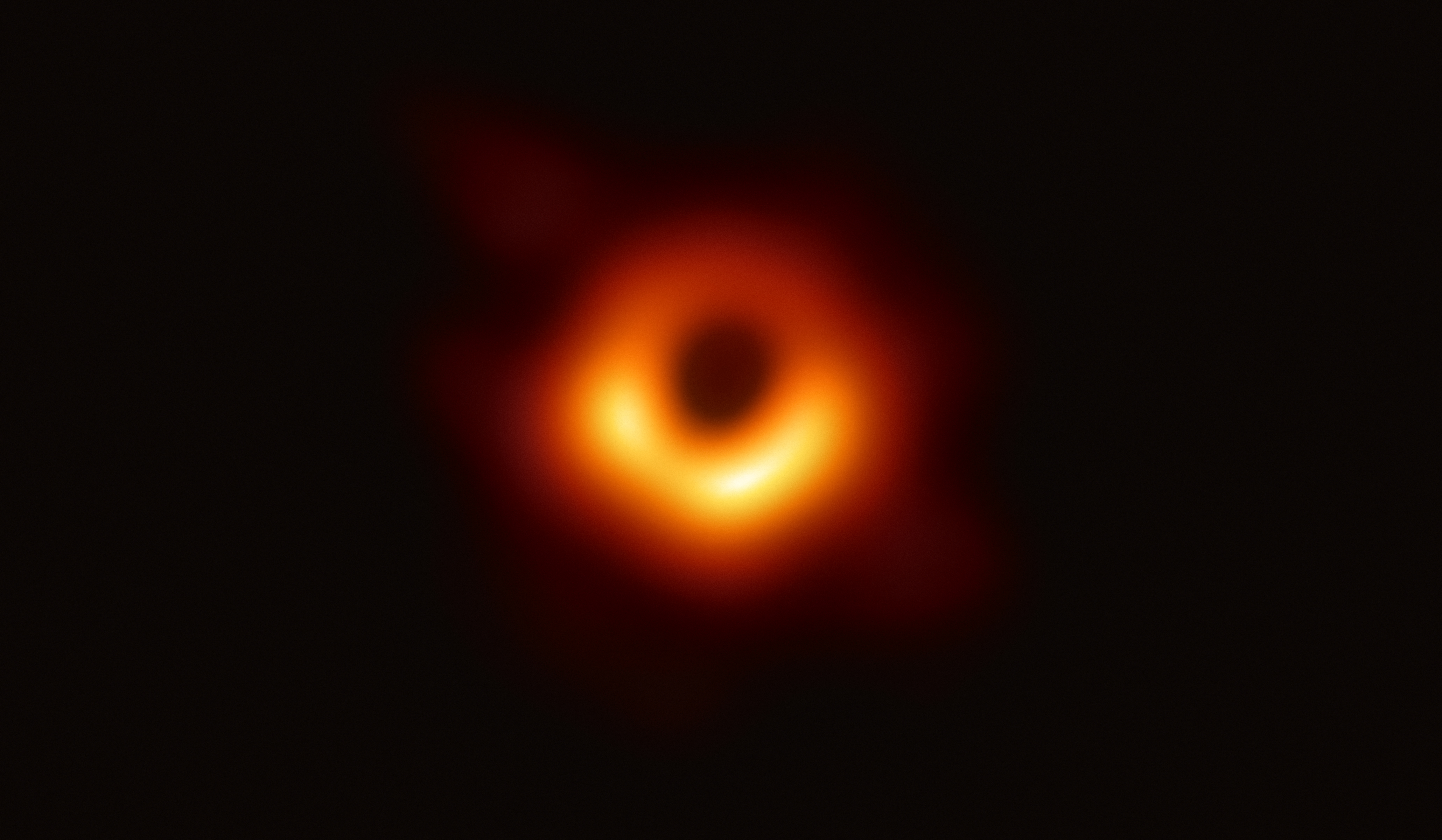 Figure 14: Image of M87 black hole from the Event Horizon Telecope. It’s the real deal!
Figure 14: Image of M87 black hole from the Event Horizon Telecope. It’s the real deal!
Credit: EHT Collaboration (https://www.eso.org/public/images/eso1907a/)
Let me try to summarize what I believe we should be saying about black holes.
I think that the best way to describe a black hole is as a region of spacetime that is cut off from the rest of the universe. The presence of mass/energy/momentum/etc. (“stuff”) alters the relationships in spacetime that we call gravity (technically the ‘metric’). When the distortion is very large (i.e. when we get enough stuff into a small enough region) it detaches time ‘inside’ that region from time ‘outside’. The boundary is what we call the event horizon.
Describing the boundary is really all one can say about the black hole. All the properties of the black hole, including its mass, can be seen as present outside or on that boundary. This means that they can ‘leak’ away into space and time through processes such as Hawking Radiation and collisions of black holes, but this does not involve anything ‘escaping’ the inside of the black hole.
Because the event horizon boundary is in time, not just in space, it is not meaningful to talk about what is inside the black hole “now”, because there is no connection between time inside and outside. The time inside the black hole is very different and runs inwards. The centre of the black hole is not just metaphorically but literally the future for anything crossing that boundary, and moving away from the singularity would be moving backwards in time.
In theory we should still be able to describe that cut-off region as well as our own, and mostly we can. But these descriptions cannot avoid including a singularity, which is usually taken to show that general relativity is incomplete and a more complete version would show something different happening at that point. It is, however, unlikely that any modification to general relativity can avoid event horizons and such cut-off regions of spacetime.
Now that we have some images of an actual black hole which match the predictions of the theory, it seems even more certain that there really are such extreme places, but we have a tremendous amount still to learn about them!
Tags: Astronomy, Cosmology, Field Theory, Modern Physics



















